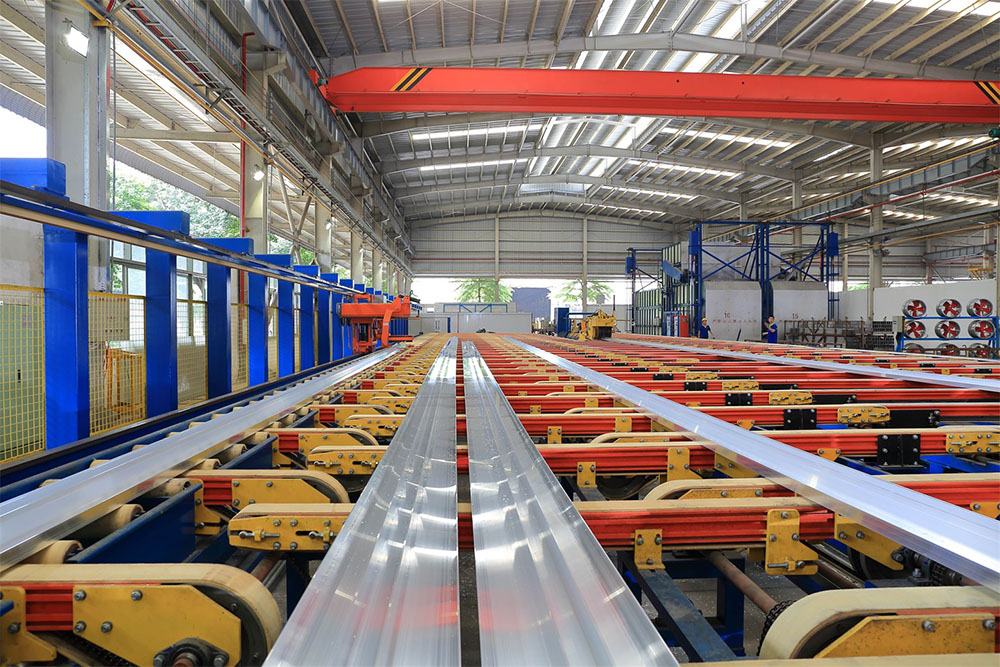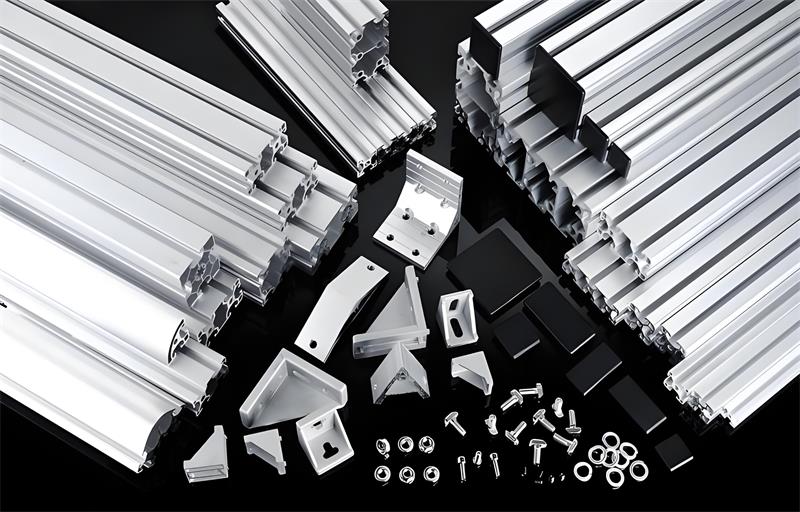What Are Aluminium Profiles Used For?

What Are Aluminium Profiles Used For?
Aluminium profiles are an integral component across various industries, owing to their unique properties such as lightweight structure, high strength, corrosion resistance, and versatility. These profiles are used to create structures and components that are both functional and aesthetically pleasing, providing solutions in industries ranging from construction and architecture to electronics and transportation.
In this comprehensive article, we will delve into the wide-ranging uses of aluminium profiles, exploring how different industries leverage their qualities for diverse applications. Additionally, we will provide insight into the various types of aluminium profiles, their role in specific applications, and how advancements in manufacturing, spearheaded by companies like Aluinno Aluminum, are shaping the future of this indispensable material.
Table of Contents
1. Introduction
2. What Are Aluminium Profiles?
3. Aluminium Profiles in the Construction Industry
4. Automotive and Transportation Uses of Aluminium Profiles
5. Aluminium Profiles in Electronics and Electrical Applications
6. Role of Aluminium Profiles in the Aerospace Industry
7. Applications in the Furniture Industry
8. Aluminium Profiles in Renewable Energy and Solar Systems
9. Custom Aluminium Profiles for Special Projects
10. Environmental and Sustainability Benefits of Using Aluminium Profiles
11. Surface Finishes and Treatments for Specific Applications
12. How Aluinno Aluminum Meets Industry Needs
13. Advances in Aluminium Profile Technology and Innovation
14. Conclusion
15. FAQs
1. Introduction
Aluminium profiles play a crucial role in modern engineering, construction, and manufacturing. These profiles are created by extruding aluminium into specific shapes, allowing them to meet various structural, functional, and aesthetic needs. Aluminium profiles are used in countless applications thanks to their unique properties, which include lightweight yet strong structures, corrosion resistance, and ease of fabrication.
This guide will explore the multitude of ways aluminium profiles are utilized across different industries and how selecting the right profile can significantly impact the success of a project. By the end of this article, you will have a clearer understanding of the importance of aluminium profiles and how leading manufacturers like Aluinno Aluminum continue to push the boundaries of what’s possible with this versatile material.
2. What Are Aluminium Profiles?
Aluminium profiles are extruded aluminium products designed to meet various design and engineering requirements. The extrusion process involves heating aluminium and forcing it through a die to create specific cross-sectional shapes. These shapes can range from simple rectangles and tubes to complex, custom-designed geometries, depending on the needs of the application.
One of the main advantages of aluminium profiles is their versatility. They can be engineered to perform in both structural and decorative roles, with applications spanning across industries such as construction, automotive, electronics, aerospace, and more. Their ability to combine strength, corrosion resistance, and aesthetic flexibility makes them a go-to material for manufacturers and designers alike.
3. Aluminium Profiles in the Construction Industry
Perhaps one of the most prominent uses of aluminium profiles is in the construction industry. Here, they are valued for their strength, lightweight properties, and resistance to environmental factors such as moisture and UV exposure. Aluminium profiles are often chosen for both exterior and interior architectural elements due to their durability and versatility in design.
Common Uses of Aluminium Profiles in Construction:
1. Window and Door Frames: Aluminium profiles are extensively used in modern window and door systems. They offer a sleek, durable, and corrosion-resistant solution that can withstand weather exposure while maintaining excellent thermal and acoustic insulation properties.
2. Curtain Walls: Aluminium profiles are essential in creating curtain wall systems for large buildings. Curtain walls are lightweight, non-load-bearing structures attached to the exterior of buildings, and aluminium’s corrosion resistance makes it ideal for this application.
3. Roofing Systems: In commercial and industrial buildings, aluminium profiles are commonly used in roofing systems. Their resistance to environmental damage, coupled with their ability to be easily shaped, makes them a preferred material for both flat and sloped roofs.
4. Structural Supports: Aluminium profiles are used in various structural components such as frames, beams, and columns in both residential and commercial buildings. Thanks to their high strength-to-weight ratio, they provide excellent support without adding unnecessary weight.
5. Balustrades and Railings: For safety and design purposes, aluminium profiles are often used to create balustrades and railings, particularly in outdoor spaces like balconies, staircases, and terraces. These profiles are both functional and aesthetically versatile, available in a variety of finishes.
4. Automotive and Transportation Uses of Aluminium Profiles
The automotive and transportation industries have increasingly turned to aluminium profiles for the construction of vehicles, trains, and other modes of transportation. The primary reason for this is aluminium’s combination of lightweight and high-strength properties, which contribute to enhanced fuel efficiency and lower emissions by reducing the overall weight of vehicles.
Key Applications of Aluminium Profiles in Transportation:
1. Vehicle Frames and Chassis: Aluminium profiles are widely used in the production of car frames and chassis, especially in electric vehicles where reducing weight is critical for improving battery range and performance.
2. Body Panels and Exterior Components: Aluminium profiles are also employed in body panels, bumpers, and other exterior components. These profiles help reduce the overall weight of the vehicle while providing excellent impact resistance.
3. Train and Rail Components: In railway systems, aluminium profiles are used in the construction of train carriages and supporting structures. Their lightweight nature helps improve energy efficiency and enables faster acceleration and deceleration of trains.
4. Bicycle Frames: High-end bicycles often use aluminium profiles for their frames. Aluminium provides the necessary strength for cycling while keeping the frame lightweight, making it easier to maneuver and improving performance.
5. Aluminium Profiles in Electronics and Electrical Applications
The unique thermal conductivity and electrical properties of aluminium make it an ideal material for use in electronics and electrical systems. Aluminium profiles are frequently used in components where heat dissipation and efficient conduction are crucial.
Common Electronic Applications of Aluminium Profiles:
1. Heat Sinks: Aluminium profiles are the preferred choice for heat sinks in electronics due to their excellent ability to dissipate heat. They are commonly used in computer components, LED lighting systems, and other devices that generate significant amounts of heat.
2. Enclosures and Casings: Many electronic devices use aluminium profiles to create protective enclosures and casings for sensitive components. Aluminium’s durability and resistance to corrosion make it a reliable option for protecting electronics in harsh environments.
3. Conductive Bus Bars: In electrical systems, aluminium profiles are often used to create conductive bus bars. These bus bars are responsible for distributing electricity within electrical panels, ensuring efficient energy transmission.
4. Lighting Systems: Aluminium profiles are commonly used in LED lighting systems. Their ability to act as both a housing and a heat sink ensures that LED lights can function efficiently over long periods without overheating.
6. Role of Aluminium Profiles in the Aerospace Industry
The aerospace industry demands materials that are both lightweight and incredibly strong, making aluminium profiles a natural fit. Their high strength-to-weight ratio, combined with corrosion resistance and durability, makes aluminium a critical material in the construction of aircraft and spacecraft.
Applications of Aluminium Profiles in Aerospace:
1. Aircraft Frames and Structures: Aluminium profiles are used in the construction of aircraft frames, wings, and fuselages. These components need to be lightweight to reduce fuel consumption and enhance performance, while still being strong enough to withstand the extreme forces experienced during flight.
2. Interior Components: Aluminium profiles are also used in aircraft interiors, including seats, overhead bins, and cabin partitions. Their lightweight nature contributes to overall fuel efficiency while maintaining the structural integrity of the aircraft.
3. Landing Gear: Many components of aircraft landing gear systems are made from aluminium profiles due to their ability to absorb impact and resist corrosion from environmental exposure.
4. Satellite Structures: Aluminium profiles are also used in space exploration, forming the structural framework for satellites and other space-bound vehicles. The material's low weight and resistance to corrosion in the vacuum of space make it an ideal choice.
7. Applications in the Furniture Industry
Aluminium profiles are widely used in modern furniture design, particularly for office furniture, modular systems, and lightweight, sleek designs. The material’s aesthetic appeal, combined with its durability and flexibility, makes it ideal for various furniture applications.
Furniture Applications of Aluminium Profiles:
1. Modular Office Systems: Aluminium profiles are commonly used to create modular office partitions, desks, and shelving systems. The material allows for flexible design configurations, enabling easy reorganization of office spaces.
2. Frame Structures: Many modern tables, chairs, and cabinets feature aluminium frames. These profiles provide the necessary structural support while offering a clean and minimalist design.
3. Decorative Elements: In addition to providing structural support, aluminium profiles are often used as decorative elements in furniture. They can be anodized or powder-coated in a variety of finishes to match different design aesthetics.
4. Outdoor Furniture: Aluminium’s corrosion resistance makes it an excellent choice for outdoor furniture, where exposure to moisture and the elements is a concern.
8. Aluminium Profiles in Renewable Energy and Solar Systems
With the increasing focus on renewable energy, aluminium profiles are playing a critical role in supporting sustainable energy solutions, particularly in solar energy systems.
Key Applications in Renewable Energy:
1. Solar Panel Frames: Aluminium profiles are extensively used to create frames for solar panels. These frames are lightweight, corrosion-resistant, and strong enough to withstand outdoor conditions, making them ideal for long-term installations.
2. Mounting Systems: Solar panel mounting systems rely heavily on aluminium profiles for their structural support. These systems must be durable and lightweight to facilitate easy installation and maintenance.
3. Wind Turbine Components: Aluminium profiles are also used in the construction of wind turbine components, including the nacelle and internal frameworks, where weight reduction is crucial to optimize performance.
4. Energy Storage Systems: In renewable energy storage solutions, aluminium profiles are often used to create the enclosures and support structures for battery systems. Their thermal conductivity and durability make them well-suited for this application.
9. Custom Aluminium Profiles for Special Projects
While standard aluminium profiles serve a wide range of applications, some projects require custom-designed profiles tailored to meet unique specifications. Custom profiles allow for more flexibility in terms of shape, size, and alloy selection, enabling manufacturers to create solutions that meet specific engineering challenges.
Benefits of Custom Aluminium Profiles:
1. Precision Engineering: Custom profiles can be designed to fit exact dimensional requirements, ensuring a perfect fit for complex systems.
2. Enhanced Performance: By designing profiles with specific mechanical properties in mind, manufacturers can optimize performance in areas such as load-bearing capacity, thermal management, or aerodynamic efficiency.
3. Unique Aesthetic Designs: Custom aluminium profiles allow for creative freedom in architectural and decorative projects, offering unique shapes and finishes not available with standard profiles.
Companies like Aluinno Aluminum specialize in creating custom aluminium profiles that meet the precise needs of their clients, whether for industrial, architectural, or specialized applications.
10. Environmental and Sustainability Benefits of Using Aluminium Profiles
Aluminium is one of the most sustainable materials available today. Its recyclability and energy efficiency make it an eco-friendly choice for industries looking to reduce their environmental impact. Aluminium can be recycled indefinitely without losing its properties, and the recycling process uses only a fraction of the energy required to produce new aluminium.
Environmental Benefits of Aluminium:
1. Recyclability: Nearly 75% of all aluminium ever produced is still in use today, thanks to its recyclability. Recycling aluminium saves up to 95% of the energy needed to produce new aluminium.
2. Energy Efficiency: The lightweight nature of aluminium profiles helps reduce energy consumption in industries such as automotive and aerospace, where reducing vehicle weight translates to better fuel efficiency.
3. Long Lifespan: Aluminium profiles are incredibly durable, offering long-lasting performance even in harsh environmental conditions. This reduces the need for frequent replacements, further contributing to sustainability.
11. Surface Finishes and Treatments for Specific Applications
Aluminium profiles are often treated with various surface finishes to enhance their appearance, corrosion resistance, and durability. The choice of surface treatment depends on the application and the environment in which the profile will be used.
Common Surface Treatments for Aluminium Profiles:
1. Anodizing: Anodizing creates a protective oxide layer on the surface of the aluminium, increasing corrosion resistance and wear. It also allows for color customization, making anodized aluminium popular in architectural and decorative applications.
2. Powder Coating: This process involves applying a dry powder to the aluminium surface, which is then cured to create a durable, colored finish. Powder-coated profiles are used in furniture, automotive components, and outdoor structures where a visually appealing and weather-resistant finish is needed.
3. Polishing and Brushing: For applications where aesthetics are important, aluminium profiles can be polished or brushed to achieve a shiny or matte finish. These finishes are commonly used in furniture and interior design.
12. How Aluinno Aluminum Meets Industry Needs
Aluinno Aluminum is a leader in the aluminium profile industry, offering both standard and custom profiles for a wide range of applications. Their expertise in alloy selection, surface treatments, and extrusion techniques ensures that clients receive high-quality products tailored to their specific needs.
How Aluinno Aluminum Stands Out:
1. Custom Solutions: Aluinno Aluminum works closely with clients to create custom profiles that meet the exact specifications of their projects, whether they are in the construction, automotive, or renewable energy sectors.
2. Advanced Manufacturing: By utilizing the latest extrusion technologies, Aluinno Aluminum produces profiles with tight tolerances and complex geometries, ensuring precision and performance.
3. Sustainability Commitment: Aluinno Aluminum is committed to sustainable manufacturing practices, using recycled materials and energy-efficient production methods to reduce their environmental impact.
13. Advances in Aluminium Profile Technology and Innovation
The aluminium profile industry has seen significant technological advancements in recent years, particularly in extrusion techniques, alloy development, and surface treatments. These innovations have led to stronger, lighter, and more durable profiles, opening up new possibilities for their use in advanced applications such as renewable energy, aerospace, and smart technology.
Recent Innovations:
1. High-Precision Extrusion: Advances in extrusion technology allow for the creation of more complex and precise aluminium profiles, making them suitable for cutting-edge applications that require tight tolerances.
2. New Alloy Development: Modern alloys offer improved strength-to-weight ratios and enhanced corrosion resistance, expanding the range of industries that can benefit from aluminium profiles.
3. Surface Treatment Technology: Innovations in anodizing and powder coating have led to more durable and aesthetically pleasing finishes, making aluminium profiles an even more attractive option for architects and designers.
14. Conclusion
Aluminium profiles are an essential material used in countless industries, providing strength, versatility, and durability across a broad range of applications. From construction and automotive to electronics and renewable energy, aluminium profiles play a crucial role in enabling the design and manufacture of modern products and systems.
As a leader in the aluminium profile industry, Aluinno Aluminum continues to push the boundaries of what’s possible, offering innovative solutions that meet the needs of their clients. Whether you require standard profiles or custom-designed components, choosing the right aluminium profile is critical for the success of your project.
15. Frequently Asked Questions (FAQs)
1. What industries use aluminium profiles the most?
Aluminium profiles are commonly used in construction, automotive, aerospace, electronics, and renewable energy sectors.
2. Why are aluminium profiles so popular in construction?
Aluminium profiles are lightweight, corrosion-resistant, and easy to fabricate, making them ideal for windows, doors, curtain walls, and structural components in buildings.
3. Can aluminium profiles be recycled?
Yes, aluminium is 100% recyclable and can be recycled indefinitely without losing its mechanical properties, making it one of the most sustainable materials available.
4. How are custom aluminium profiles made?
Custom aluminium profiles are created through a process called extrusion, where heated aluminium is forced through a die designed to create the desired shape.
5. What are the benefits of anodized aluminium profiles?
Anodizing increases corrosion resistance and wear while also allowing for color customization, making it a popular choice in architectural and decorative applications.


 En
En



 Location:
Location:
















